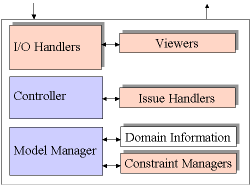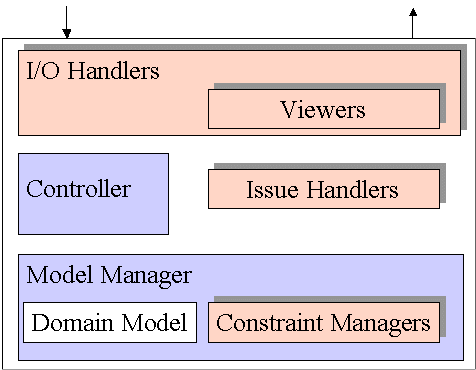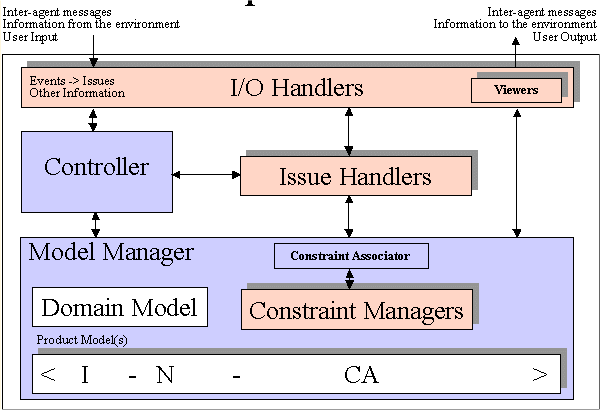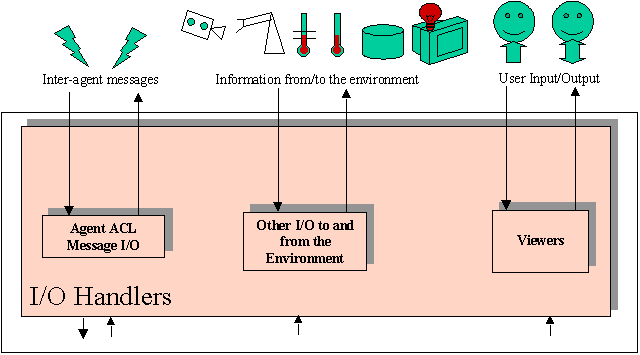I-X: Technology for Intelligent Agents & Tools
Systems Architecture |
 |
Work in Intelligent Planning and Activity Management at the University
of Edinburgh (See http://www.aiai.ed.ac.uk/project/plan/)
has led to a number of significant assets that are re-used on a number
of projects. These assets include: Nonlin, O-Plan, <I-N-OVA>,
Enterprise Ontology, Enterprise Architecture, Task Manager,
O-P3 Process Panels, Common Process
Editor, etc. A new generation of the work will draw on these earlier efforts,
generalise them, and significantly extend the application of the core
concepts and assets, leading to new re-usable components, and create
opportunities for applications and further research.

This new programme is called I-X and the core components are a
shared model representation called <I-N-CA> and a related
systems integration architecture called I-Core. A variety of
re-usable components and systems will be build on the new architecture
and these will be collectively referred to as I-Technology and
I-Tools.
The "I" in I-X and I-Technology reflects the following:
- Intelligent - I-X supports the construction of intelligent systems
and intelligent agents
- Intelligible - I-X supports the construction of systems which are
intelligible to their users and to other systems and agents.
- Integration - I-X is a systems integration architecture
- Issue-based - I-X is an issue-based and issue handling architecture
Some factors which motivate the I-X work are:
- Human-friendly representations of plans for human communication
and cooperation, as well as man-machine interaction in areas such as
mixed initiative planning.
- Plan and activity representation ontologies and their potential
to assist in the knowledge acquisition and knowledge management process.
- Plan representations well suited to storage and for use in
markup languages such as XML.
- Plan representation languages which are also suitable for use to
represent the planning (task setting, planning, scheduling and
execution) process.
- Bringing AI plan and agent capability description experience into
practical use.
- Relationship to emerging standards (NIST PSL, ISO, WfMC, etc).
We propose to bring together a number of threads of previous research
and development, and use state-of-the-art understanding of the
conceptual basis for flexible, incremental, mixed-initiative planning
and activity management systems. We will incorporate these into an
open, flexible, lightweight and embeddable system. This will be
written in Java for portability and to maximise reuse potential. The
core of the system will be an agenda-based issue handling system based
on workflow principles. It will be specialised to any particular task
by incorporating suitable issue-handling capabilities which could be
supplied by human or system components. It will be designed to allow
for very significant extension via an open capability plug-in
interface and via an interface to allow for the use of constraint
management methods, feasibility estimators, simulators, etc. The
system will be able to inter-work with other workflow and cooperative
working support systems, and will not make assumptions about the
internal architecture of those other systems.
I-X provides a new systems integration architecture. It can be used to
create agents or non-agent systems. Its design is based on the O-Plan
planning agent architecture. I-Core incorporates components and
interface specifications which account for simplifications,
abstractions and clarifications in the O-Plan work. I-Core provides
an issue-handling workflow style of architecture, with reasoning and
functional capabilities provided as plug-ins. Also via plug-ins it
allows for sophisticated management and use of the internal model
representations to reflect the application domain of the system being
built in I-Core. I-Core systems or agents may be recursively or fractally
composed, and may interwork with other processing cells or
architectures. This is a systems integration approach now being
advocated by a number of groups concerned with large scale,
long-lived, evolving and diverse systems integration issues.
The I-Technology programme has 5 aspects:
- Systems Integration - A broad vision of an open
architecture for the creation of intelligent systems for the synthesis
of a result or "product" which is based on a "two cycle" approach which
uses plug-in components to "handle issues" and to "manage and respect
the domain model".
- Representation - a core notion of the representation of a
synthesised product as a set of nodes making up the components of the
product, along with constraints on the relationship between
those nodes and a set of outstanding issues - <I-N-CA> - Issues,
Nodes, Critical Constraints and Auxiliary Constraints.
- Reasoning - the provision of reusable reasoning and model
management capabilities.
- Viewers & User Interfaces - to understand user roles in
performing activities and to provide generic modules which present the
state of the process they are engaged in, their relationships to
others and the status of the artifacts/products they are working
with.
- Applications - work in various application sectors which
will seek to create generic approaches (I-Tools) for the
various types of Task in which users may engage.
I-Core
The components of I-Core are as follows:
- Task and Option Management - the Controller
-- The capability to support user tasks via appropriate use of the
processing and information assets and to assist the user in
managing options being used within the model.
- Issue Handlers
-- Functional components (distinguished into those which
can add nodes to the model (synthesis) and those which analyse the model (to
add information only).
- Model Management
-- coordination of the capabilities/assets to represent, store,
retrieve, merge, translate, compare, correct, analyse, synthesise and
modify models.
- Constraint Managers
-- Components which assist in the maintenance of the consistency
of the model.
- Viewers
-- User interface, visualisation and presentation viewers for the model -
sometimes differentiated into technical model views (charts, structure
diagrams, etc.) and world model views (simulations, animations, etc.)

A number of different types of internal interfaces are available
within the framework to reflect the protocols or interfaces into which
the various components can fit. The separation into viewers, Issue
handlers or processing assets, constraint managers and information
assets has been found to be useful in a number of AIAI projects. This
also puts the I-X work on a convergent path with other
Model/Viewer/Controller styles of systems framework.

<I-N-CA> Ontology
The <I-N-CA> (Issues - Nodes - Critical/Auxiliary) constraint
approach to describing synthesised artifacts (results, models, plans,
configurations, designs) defines a set of "nodes" to be included in
the design, along with "constraints" on how these nodes can be related
to one another and the environment they exist in. It also includes a
set of outstanding "issues" related to the artifact(s).
The <I-N-CA> constraints model is a means to represent
synthesised or designed artifacts as a set of constraints on the space
of possible designs. By having a clear description of the different
components within a synthesised artifact, the model allows for them to
be manipulated and used separately from the environments in which they
are generated.
The constraints which add a node (these are in the form ``include
node'') in the <I-N-CA> model set the space within which the
description of the artifact may be further constrained.
The I (issues) state the outstanding items to be handled and can
represent unsatisfied objectives, problems which analysis has shown
need to be addressed, etc. The I constraints can be thought of as
implying further constraints which may have to be added into the
design in future in order to address the outstanding issues.
The CA constraints restrict the relationships between the nodes to
describe only those artifacts within the design space which meet the
requirements. The constraints are split into "critical constraints"
and "auxiliary constraints" depending on whether some constraint
managers (solvers) can return them as "maybe" answers to indicate that
the constraint being added to the model is okay so long as other
critical constraints are imposed. The maybe answer is returned as a
disjunction of conjunctions of critical constraints.
The use of "maybe", delayed and/or conditional constraint results
from problem solvers is common in AI planning where one of the main
world state condition/effect solvers many of us use is the modal truth
criterion (MTC) based on Tate's work on the Nonlin "QA Algorithm" in
the mid 1970s. This established whether some condition was satisfied
at some point in a partial ordering of activities in a plan. In later
Edinburgh planning work, the same interface is used a general model
for constraint solvers being plugged into a planner - or indeed any
synthesis system.
For example, if the product or artifact is an activity
plan, some types of ordering (temporal) and variable (object)
constraints are distinguished from all other auxiliary constraints
since these act as critical constraints or cross
constraints, usually being involved in describing the others --
such as in a resource constraint which will often refer to
objects/variables and to time points or intervals.
We are also promoting a knowledge modelling approach in AKT
which is thought of as a synthesis of the model from multiple human and
system sources using any modelling methods and approaches or tools.
This would build "nodes" in the model as appropriate to the domain,
and build constraints on those nodes. It would maintain a set of
outstanding modelling issues. It would use terminology in a domain
ontology that was being concurrently defined alongside the modelling,
so it itself would be a result of the modelling. It would allow a
wide range of reasoning approaches and sub-solvers to be employed as
appropriate to the tasks being conducted being found through the use
of a capability description that allowed access to the library of
capabilities (i.e. agent capabilities or problem-solving method libraries).
Issues can be categorised as to whether
they will, may or will never add a "node".
The I constraints which can lead to
the inclusion of new nodes are of a different nature in the synthesis
process to those which cannot.
The choice of which constraints are considered critical is itself a
decision for an application of I-X and I-Core. It is not
pre-determined for all applications. A temporal activity-based
planner would normally have objects/variable constraints (equality and
inequality of objects) and some temporal constraints (maybe just the
simple before(time-point1, time-point-2) constraint) as the critical
constraints. But, in a 3D design or a configuration application
object/variable and some other critical constraints (possibly spatial
constraints) might be chosen. It depends on the nature of what is
communicated between constraint managers in the application of the
architecture.
The types of constraints in an <I-N-CA> model is shown below:
I - Issues
- which may add an "include node" constraint (i.e. add nodes
to the model)
- which will not add an "include node" constraint
N - Node Constraints
- include node constraints
- other node constraints
C - Critical Constraints
E.g., if the artifact is an activity plan:
O - Critical Ordering Constraints
V - Critical Object or Variable Constraints
A - Auxiliary Constraints
E.g., if the artifact is an activity plan:
O' - Non-critical Ordering Constraints
V' - Non-critical Object or Variable Constraints
X - eXtra constraints (such as):
- Authority Constraints
- World State Constraints
- Resource Constraints
- Spatial Constraints
- Miscellaneous Constraints
Shared Models
The I-X approach involves the use of shared models for task directed
communication between human and computer agents who are jointly
exploring a range of alternative options for the synthesis of an
artifact such as a design or a plan.
A number of concepts are being used as the basis for exploring task
orientated multi-agent and mixed-initiative work involving users and
systems. Together these provide for a shared model of what
each agent can and is authorised to do and what those agents can act
upon. The concepts are:
- Shared Object/Product Model -- a structured representation
of the object being modelled or produced using a common constraint
model of the object or product (<I-N-CA>).
- Shared Task Model -- Mixed initiative model of "mutually
constraining the space of objects/products"
- Shared Space of Options -- option management.
- Shared Model of Agent Processing -- handlers for issues (functional
capabilities) and constraint managers
- Shared Understanding of Authority -- management of the authority to
do work (to handle issues) and which may take into account options
and levels of abstraction of the model of the object or product.
In particular, this work will carry forward the development of a
strong systematic ontology to underpin the models of processes and
activity - including continuing to engage in and promote its use as a
basis for standards. The work will draw on the initial efforts to
create an ontology suitable for the conceptual description of all
aspects of an organisation - the Enterprise
Ontology and on the development of a constraint model of
activity <I-N-OVA>.
The work will promote the aim that PIF, NIST PSL, OMWG CPR and SPAR
all converge on a single core model of activity based on
<I-N-CA>.
Input/Output Scenarios

A range of Input and Output scenarios are being studied to drive the
development of I-X.
- Inter-agent messages
- Robot effectors and sensors
- Thermometer with preset min and max alarms
- Continuous readout thermometer
- Database access
- Monitor output for continuous status updates and warning lights
for specific events
- User viewing agent process and model(s)
- User controlling agent process and model development
Development Areas
The initial areas of development under the I-X research programme include:
- Characterisation of the separate components of a single I-X agent
to establish what features each has and how they should differ.
Establish whether the a priori view on the separate componets is
desirable.
- Initial Java encoding experiments to establish that the envisaged plug-in
framework is feasible and to experiment with different approaches.
- Consideration of how to describe plug-in components. This is
envisaged as being in the <I-N-CA> ontology, reified in Sorted
First Order Logic and storable in XML/RDF.
- The provision of an ontology for issues and issue handler descriptions
for some sample applications of I-X: (e.g. I-Plan, I-Config).
- Consideration of how to describe the design, architecture and
implementation. Possible use of UML models.
- Initial applications of I-X (e.g. I-Plan, I-Config).
- A very simple initial application of I-X fully worked through
(PicoIX and I-Sim).
- A simple, but realistic application of a mainly manual use of I-X
(user level process management and collaboration support).
- A DERA-related sample application, possibly based on Coalition
Operations in the CoAX
Project. and which could incorporate an initial generative I-Plan
component.
Issues
Some issues to consider while refining the I-X and I-Core design are
listed here:
- Java encoding limitations and opportunities
- Delivery of any user interfaces on multiple platforms via suitable web
browsers.
- Use of XML/RDF to store intermediate results passed between
suitable agents and components and to assist in storage of those
components in a form which can be retrieved and used.
- Design to allow for the resulting components to be repackaged and re-used
as embeddable components in a wide range of other systems.
Other areas of study include:
- Presentation (about product/artifact and process)
- Visible indications of users' workflow state
- Multiple views tailored to user role, information type, etc.
- Selection of what information to display.
- Views (e.g. tables) that facilitate comparison.
- Summary form with drill-down /expansion to details.
- TechWorld Viewers
- Colour-coding of status
- Colour choice principles
- Layout principles
- Multi-user cooperation
- User roles (as distinct from physical users)
- Mixed-initiative
- Authority
- Workflow
- Issues (explicit representation and tracking of)
- Delivery (of applications, e.g. on Web)
- Portable
- Standards (XML/RDF markup)
- Familiar interfaces (e.g. Browsers)
- Low bandwidth use (e.g. cellular phones, WAP, PDA)
- Reusable frameworks and modules
- Embeddability
- Workflow
- Workflow of using the system itself
(hence meta-workflow in workflow tools)
- Process Issues
- Openness
- An architecture / framework
- Plug-in concept and implementation support
- Plug-in Issue handlers, Artifact analysers, Constraint managers,
TechWorld viewers
Scenarios
- I-Plan Planning Agent
- DERA MBP Operator Support Agent
- Emergency and Unusual Procedures Assistant
(Context sensitive Cell Phone or web access to procedural assistance)
- Multi-national
Coalition Operations
- Multi-perspective Modelling framework for
Advanced Knowledge
Technologies - AKT
- Expository Scenarios
- Meeting Room Booking Agent (Non-activity based, nodes are meetings)
- Interior Decoration Design Agent (No time points)
- PicoIX and I-Sim
- For simple coding experiments and explanations
- Example that can use probabilities within Issue Handlers and/or
Constraint Managers
 Page maintained by a.tate@ed.ac.uk,
Last updated: Thu May 29 15:48:34 2003
Page maintained by a.tate@ed.ac.uk,
Last updated: Thu May 29 15:48:34 2003





